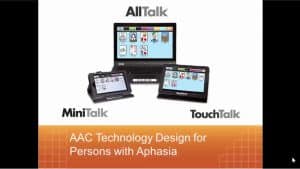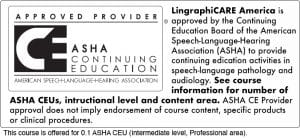 In our course on the benefits of good design in rehabilitation technologies, Speech Language Pathologists (SLPs) will learn about how AAC technology design impacts the usability and overall benefits for people with communication challenges. We’ll explore key aspects, including:
In our course on the benefits of good design in rehabilitation technologies, Speech Language Pathologists (SLPs) will learn about how AAC technology design impacts the usability and overall benefits for people with communication challenges. We’ll explore key aspects, including:
-
- the kinds of deficits frequently encountered in persons with aphasia that can make interface design adaptations worthwhile
- examples of design that address motoric deficits in this population
- examples of design that exploit autonomic responses for rehabilitative benefit
Lingraphica’s course “AAC Technology Design for Persons with Aphasia” explores the correlation between AAC design and the effectiveness and usability of high-tech AAC devices. In this course, we will discuss the importance of design geared toward usability. We will explore the benefits of good design, as well as the costs of poor design. This course will also characterize deficit areas in people with aphasia and provide actionable solutions to these challenges.
We begin by discussing Lingraphica’s AAC interface design, specifically as it applies to people with sensory deficits. For example, technology designed with right visual neglect in mind has shown to be most beneficial, as the controls are positioned to the left which allows for easy icon positioning. We will also show the benefits of icon design for linguistic clarity. Multimodal icons pull together text, speech, and graphics and are proven to be more stimulating, which improves overall processing.
Reducing motoric demands is another benefit of good AAC design. We will explore the ways in which Lingraphica technologies are designed with motor focus in mind. We will demonstrate our one-click and one-touch operational alternatives, as well as our deliberately simple controls. Each of these elements increases the usability of the technology and ultimately benefits the user.

Lingraphica technologies are designed specifically with PWAs in mind. This course will do a deep dive into the specifics of the activities and exercises we offer, including our predictive word-search algorithm and its workings. We will also explore the various automated, supportive, self-documenting exercises available for use both in therapy and at home. Finally, we will review the material with a further emphasis on designing for motor, sensory, and cognitive defects as well as designing to augment autonomic responses. We will focus specifically on practical uses and the overall benefits to the user.
AAC Technology Design for Persons with Aphasia
To learn more about rehabilitation technologies, watch our free CE course,
“AAC Technology Design for Persons with Aphasia.”




